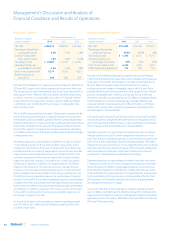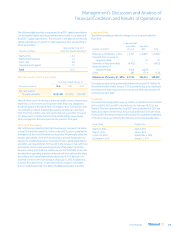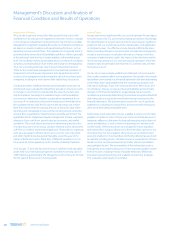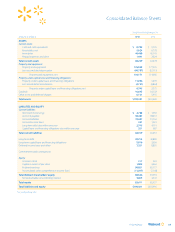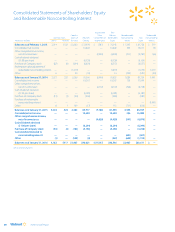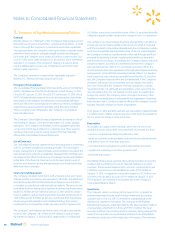Walmart 2016 Annual Report Download - page 34
Download and view the complete annual report
Please find page 34 of the 2016 Walmart annual report below. You can navigate through the pages in the report by either clicking on the pages listed below, or by using the keyword search tool below to find specific information within the annual report.
2016 Annual Report32
Management’s Discussion and Analysis of
Financial Condition and Results of Operations
Impairment of Assets
We evaluate long-lived assets other than goodwill and assets with
indefinite lives for indicators of impairment whenever events or changes
in circumstances indicate their carrying amounts may not be recoverable.
Management’s judgments regarding the existence of impairment indicators
are based on market conditions and operational performance, such as
operating income and cash flows. The evaluation for long-lived assets is
performed at the lowest level of identifiable cash flows, which is generally
at the individual store level or, in certain markets, at the market group
level. The variability of these factors depends on a number of conditions,
including uncertainty about future events and changes in demographics.
Thus, our accounting estimates may change from period to period.
These factors could cause management to conclude that indicators of
impairment exist and require impairment tests be performed, which
could result in management determining the value of long-lived assets
is impaired, resulting in a write-down of the related long-lived assets.
Goodwill and other indefinite-lived acquired intangible assets are not
amortized, but are evaluated for impairment annually or whenever events
or changes in circumstances indicate that the value of a certain asset
may be impaired. Generally, this evaluation begins with a qualitative
assessment to determine whether a quantitative impairment test is
necessary. If we determine, after performing an assessment based on
the qualitative factors, that the fair value of the reporting unit is more
likely than not less than the carrying amount, or that a fair value of the
reporting unit substantially in excess of the carrying amount cannot be
assured, then a quantitative impairment test would be performed. The
quantitative test for impairment requires management to make judgments
relating to future cash flows, growth rates and economic and market
conditions. These evaluations are based on determining the fair value
of a reporting unit or asset using a valuation method such as discounted
cash flow or a relative, market-based approach. Historically, our reporting
units have generated sufficient returns to recover the cost of goodwill
and other indefinite-lived acquired intangible assets. Because of the
nature of the factors used in these tests, if different conditions occur in
future periods, future operating results could be materially impacted.
As of January 31, 2016, the fair value of certain indefinite-lived intangible
assets held in our International segment exceeded its carrying value of
$398 million by approximately 5%. Management will continue to monitor
the fair value of these assets in future periods.
Income Taxes
Income taxes have a significant effect on our net earnings. We are subject
to income taxes in the U.S. and numerous foreign jurisdictions. Accordingly,
the determination of our provision for income taxes requires significant
judgment, the use of estimates and the interpretation and application
of complex tax laws. Our effective income tax rate is affected by many
factors, including changes in our assessment of certain tax contingencies,
increases and decreases in valuation allowances, changes in tax law,
outcomes of administrative audits, the impact of discrete items and the
mix of earnings among our U.S. and international operations where the
statutory rates are generally lower than the U.S. statutory rate, and may
fluctuate as a result.
Our tax returns are routinely audited and settlements of issues raised in
these audits sometimes affect our tax provisions. The benefits of uncertain
tax positions are recorded in our financial statements only after determining
a more likely than not probability that the uncertain tax positions will
withstand challenge, if any, from taxing authorities. When facts and
circumstances change, we reassess these probabilities and record any
changes in the financial statements as appropriate. We account for
uncertain tax positions by determining the minimum recognition threshold
that a tax position is required to meet before being recognized in the
financial statements. This determination requires the use of significant
judgment in evaluating our tax positions and assessing the timing and
amounts of deductible and taxable items.
Deferred tax assets represent amounts available to reduce income taxes
payable on taxable income in future years. Such assets arise because of
temporary differences between the financial reporting and tax bases of
assets and liabilities, as well as from net operating loss and tax credit
carryforwards. Deferred tax assets are evaluated for future realization
and reduced by a valuation allowance to the extent that a portion is not
more likely than not to be realized. Many factors are considered when
assessing whether it is more likely than not that the deferred tax assets will
be realized, including recent cumulative earnings, expectations of future
taxable income, carryforward periods and other relevant quantitative
and qualitative factors. The recoverability of the deferred tax assets is
evaluated by assessing the adequacy of future expected taxable income
from all sources, including reversal of taxable temporary differences,
forecasted operating earnings and available tax planning strategies.
This evaluation relies heavily on estimates.




